“Furnace” Microscopes
by Brian Stevenson
last updated March 2024
Collectors of antique microscopes are likely familiar with small, drum-style compound microscopes that can mount in slits on top of their wooden cases (Figure 1). These are often called “furnace” microscopes, due to their resemblance of a furnace with chimney.
Most collectors also probably know that The Billings Microscope Collection catalogue attributed production of furnace microscopes to a person in Paris named “Bertrand”, with production in 1839 (Figure 2). The authors of the catalogue did not provide evidence for either the maker or date. Many of the dates given in The Billings Microscope Collection tend to be over-early; furnace microscopes do not resemble French drum microscope styles of the 1830s or 1840s. As described below, they probably date from the late 1850s until the early 1920s.
The only person in Paris named “Bertrand” who is known to have been associated with microscopes during the 1800s was Emile Bertrand (1844-1909). During his time as a student in the School of Mines of Paris in the late 1860s, Emile Bertrand built an advanced petrological microscope that included several novel features, including what came to be known as the “Bertrand lens”. Around 1880, he built an even better petrological microscope. Although his microscopes were one-offs for his own use, they were described in important microscope publications, along with laments that Emile Bertrand did not manufacture his microscopes for commercial sale. Thus, there are no firm reasons to assume that Emile Bertrand was either the inventor or manufacturer of furnace microscopes.
Examination of furnace microscopes reveal that they come in two sizes (Figure 1). The smaller form stands about 3 inches (75 mm) tall, with a wood case that measures 3 3/8 inches (81 mm) wide, 1 7/8 inches 47 mm) deep, and 1 7/16 inches 36 mm) tall. The corners are usually rounded, the slot for the microscope opens toward the front of the case, and it closes with a single, central clasp. The larger form stands about 3 3/8 inches (85 mm) tall, with a case that measures 4 inches (20 mm) wide, 2 5/16 inches (58 mm) deep, and 1 3/4 inches (44 mm) tall, with squared corners, a slot that opens to the rear, and two clasps on the front.
Analyses of advertisements and retailer names attached to furnace microscopes reveal that the smaller form is the earlier one, dating from ca. 1859 until the 1880s, while the larger form was made later, dating from after the beginning of the 1900s. Evidence supporting these conclusions is presented below.
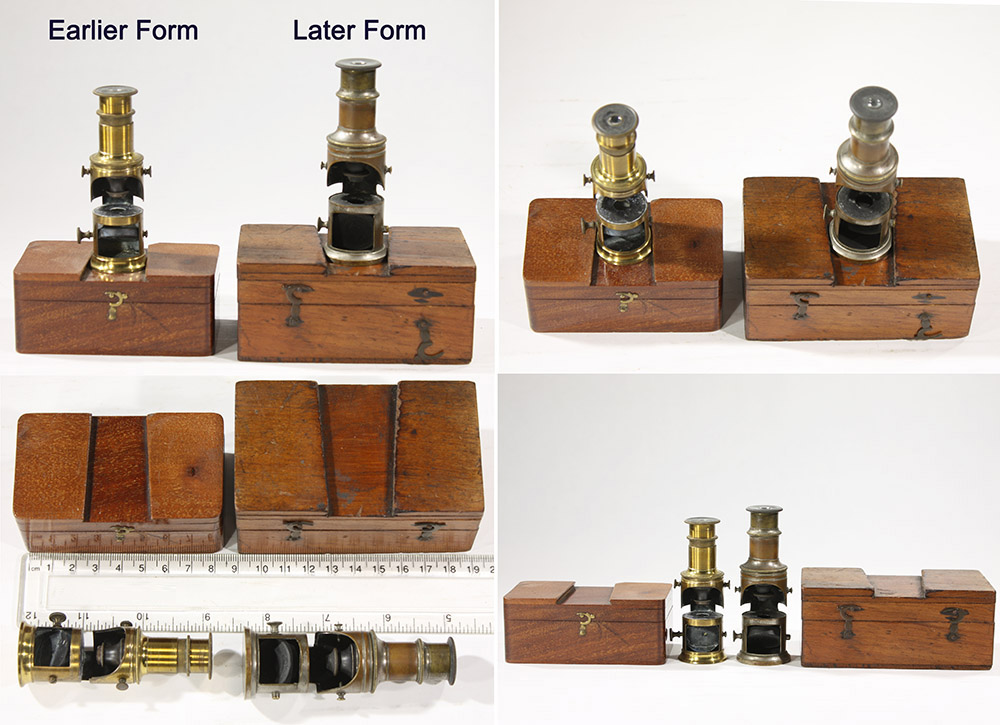
Figure 1.
The two most commonly encountered forms of “furnace” microscopes. As discussed in this essay, the smaller form is the earlier, produced ca. 1859 onward, while the larger form began production during the twentieth century. In addition to the size differences, note that the slot on the case for the earlier form usually opens toward the front of the case, and it closes with a single, central clasp, while the mounting slot of the later form usually opens to the rear, and has two clasps for the lid.
_____________________________________________________
Earlier Form Furnace Microscopes, mid- to late-1800s
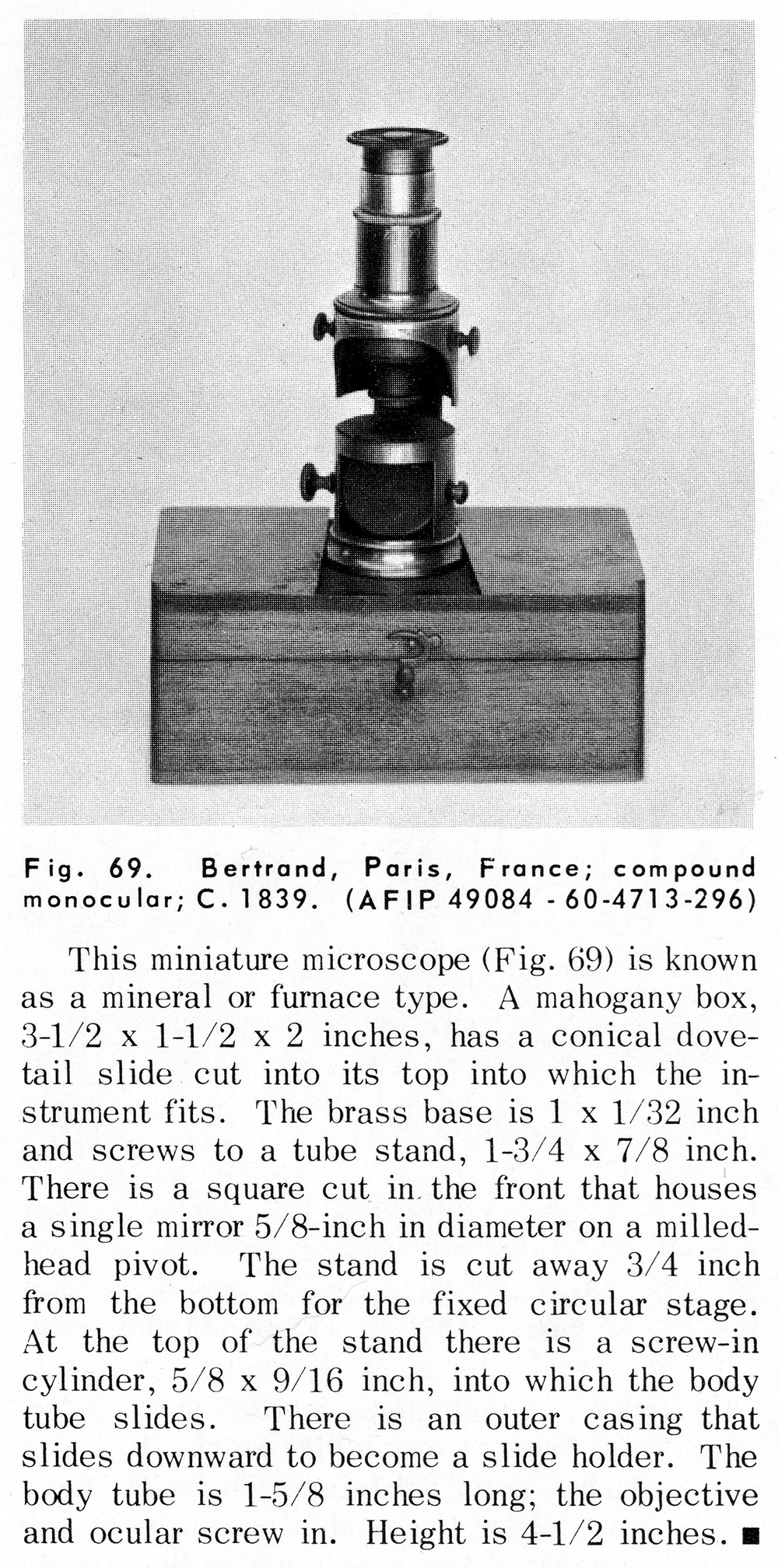
Figure 2.
Excerpt from “The Billings Microscope Collection”, with a picture of a furnace microscope, and text alleging production by “Bertrand” in 1839. As discussed in this essay, the date is probably 20+ years too early, and it was probably not produced by anyone named “Bertrand”. A possible explanation for “The Billings Microscope Collection” authors’ assumption stems from Emile Bertrand having operated a geological specimen shop in Paris during the 1870s-80s. It is possible that Bertrand sold microscopes such as this, and other scientific apparatus, and that the authors of “The Billings Microscope Collection” were aware of a microscope with Emile Bertrand’s name attached, and assumed that he was the maker. Examination of the furnace microscopes in the Billings Collection could help resolve this question.
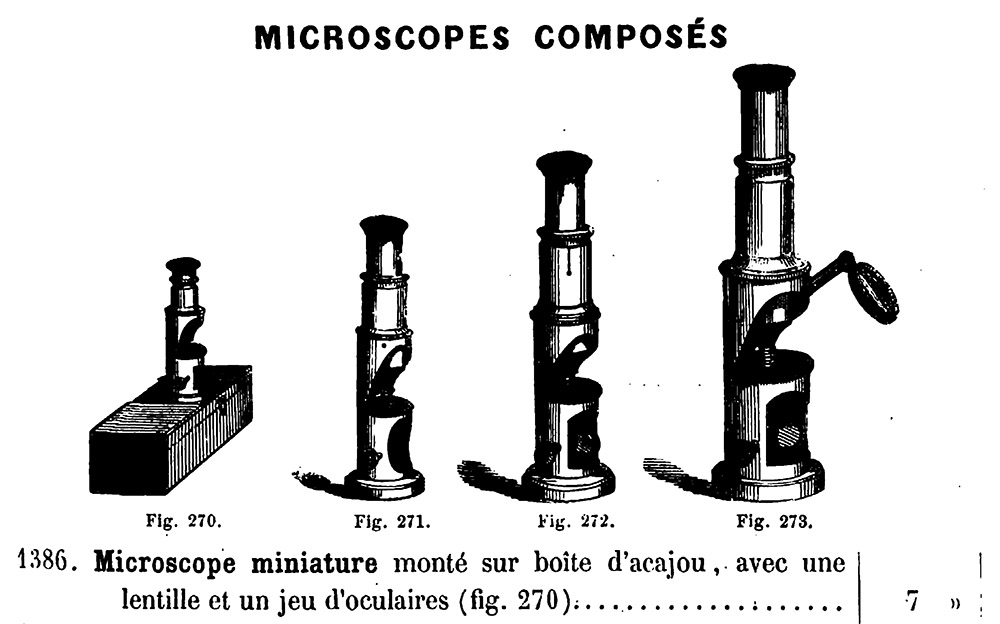
Figure 3.
The Molteni family of Paris produced a variety of microscopes and other optical instruments throughout the 1800s. This excerpt of their 1859 catalogue indicates that Molteni manufactured furnace microscopes. The business persisted until the late 1890s.
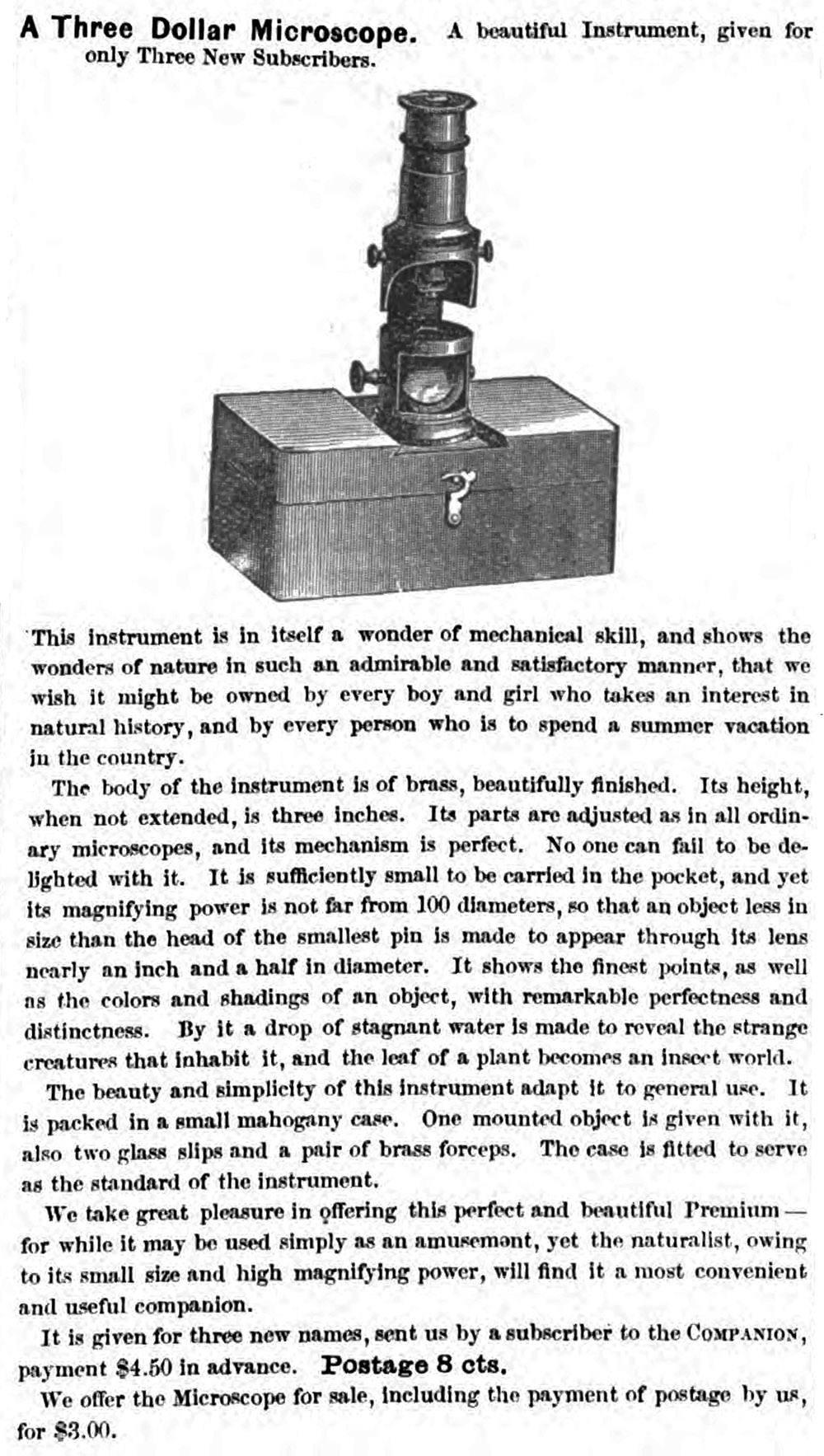
Figure 4.
This advertisement ran from 1873 until 1875 in the American magazine “Youth’s Companion”. Note that the features correspond to the earlier form of the furnace microscope. This microscope style did not appear in 1877 or later editions of the magazines.

Figure 5.
Two furnace microscopes of the earlier form that are labeled as being sold by Jacques Kubler (1834-1871), who operated an optical and scientific instruments shop in Paris from 1860 until his death, although the business was continued under his name until 1878. Thus, these two microscopes were sold between 1860 and 1878. Images from the author’s collection or adapted for nonprofit, educational purposes from an internet auction site.
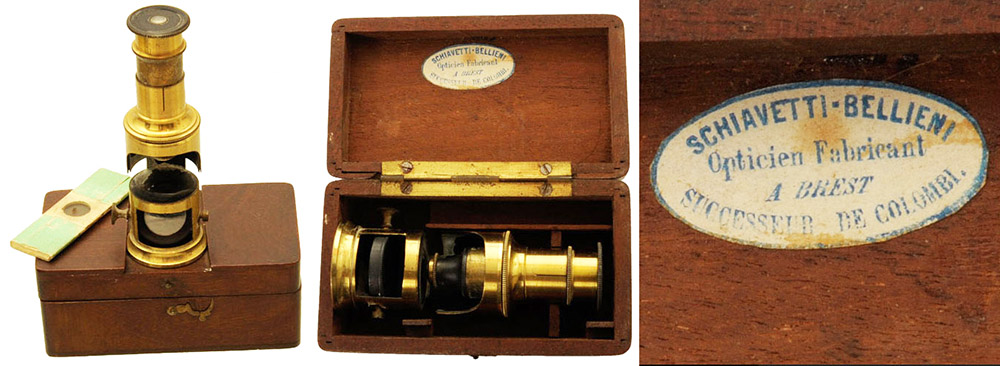
Figure 6.
An earlier form furnace microscope labeled for sale by Bernard Schiavetti-Bellieni (1813-1872). He opened his shop in Brest in 1858, and it closed upon his death in 1872. Images adapted for nonprofit, educational purposes from an internet sale site.
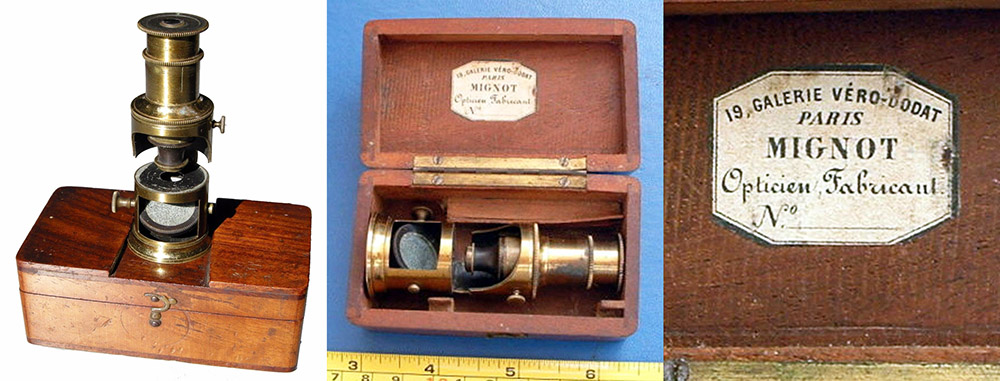
Figure 7.
Henri Emmanuel Mignot (born 1835) operated an optician’s business at Galerie Vero-Dodat, Paris, from 1861 until ca. 1871. He evidently closed the business to serve in the military during the Franco-Prussian War. Images adapted for nonprofit, educational purposes from an internet auction site.
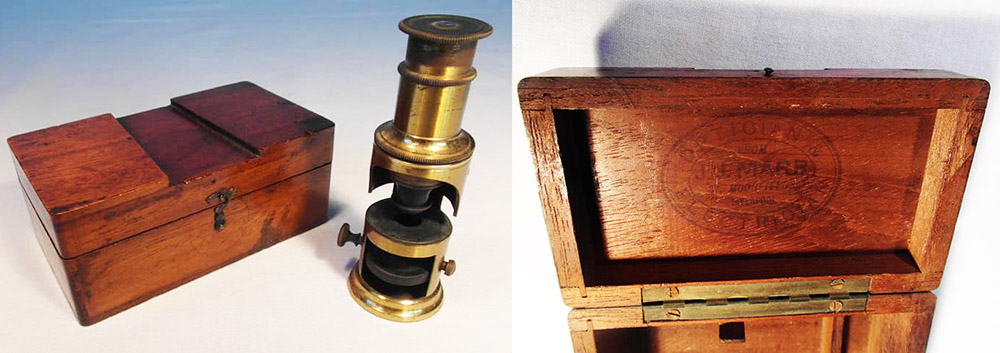
Figure 8.
John Jackson Marr (1840-1911) founded “J.J. Marr” in 1874, in Liverpool. By 1883, it was known as “J.J. Marr & Company”. Images adapted for nonprofit, educational purposes from an internet auction site.

Figure 9.
An earlier form furnace microscope that was retailed by Thompson & Company, Liverpool. John Thompson opened this shop ca. 1868. By the mid-1880s, it had been sold to Charles Aronsburg. Images adapted for nonprofit, educational purposes from an internet auction site.
_____________________________________________________
Later Form Furnace Microscopes, after 1900

Figure 10.
This later form furnace microscope has a circular inset in the lid, reading “Thos. Armstrong & Brother, Manchester, Liverpool”. This firm expanded to include a Liverpool branch in 1904, dating this microscope from after that time. Images adapted for nonprofit, educational purposes from an internet auction site.
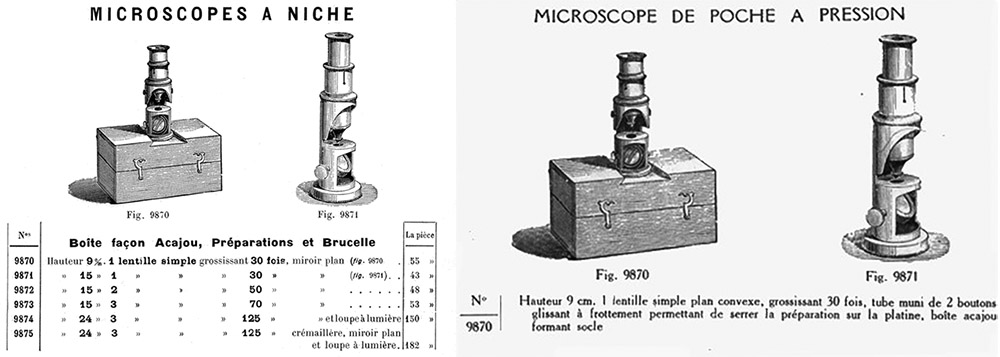
Figure 11.
Advertisements from the 1900 and 1922 catalogues of the Société des Lunetiers, Paris, showing later form furnace microscopes. This was a major manufacturer of optical apparatus, and very likely produced these microscopes in-house and supplied them to the wholesale market. Adapted by permission from
http://www.lecompendium.com/dossier_optique_40_microscopes_bertrand/microscope_bertrand.htm
and
http://www.antique-microscopes.com/photos/Bertrand_Furnace_Microscopes.htm
_____________________________________________________
Other Microscopes with Similarities to Furnace Microscopes
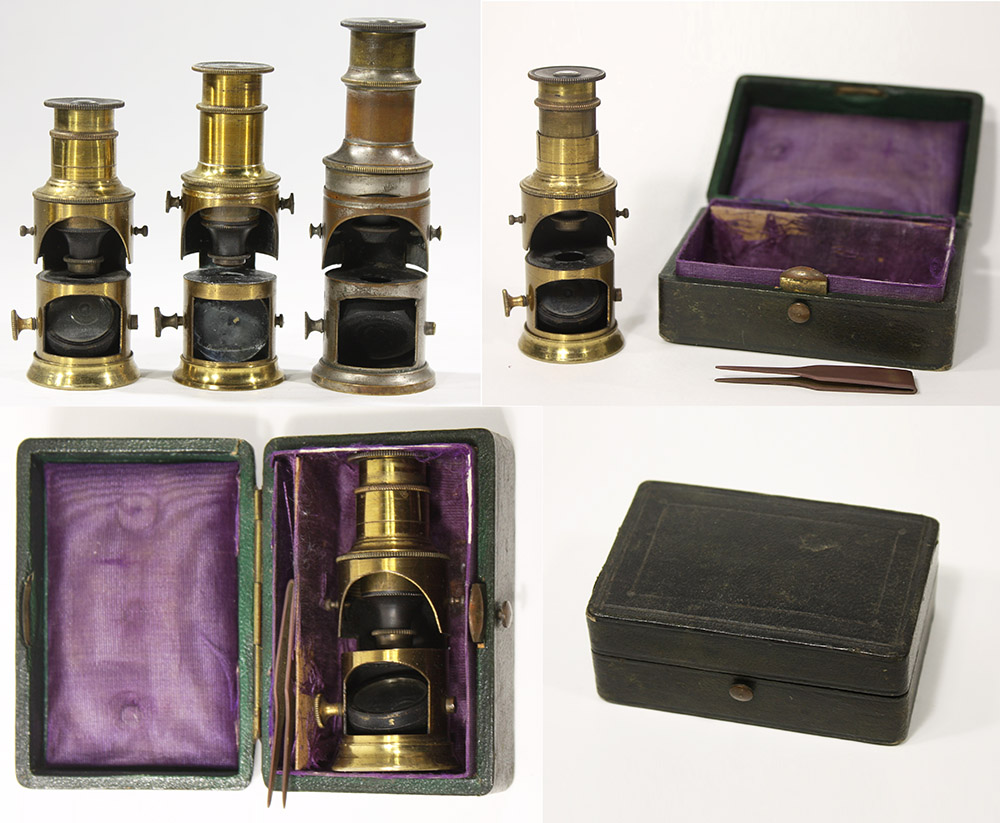
Figure 12.
A drum-style compound microscope that is even smaller than the earlier form of furnace microscope (shown on the far left, of the upper left panel), and lacks a wooden case/mount. Based on the case, it was probably made ca. 1850s-1860s, likely in France.

Figure 13.
“Microscope de Poche Miniscule”, made ca. 1913 by Manufacture Française d'Armes et Cycles de Saint-Etienne. The surviving microsope is imprinted with the maufacturer’s name and address. At the right is an excerpt from Manufacture Françaised'Armes et Cycles de Saint-Etienne’s 1913 catalogue. This model was included in their 1912, 1913, and 1914 catalogues, but not the 1911 or 1920 editions. Note that the wooden case is very similar to those of the late form furnace microscopes. Adapted by permission from http://www.lecompendium.com/dossier_optique_15_petit_microscope_droit_11cm_st_etienne/le_petit_microscope.htm
Acknowledgement
Thank you to Joe Zeligs for our many helpful conversations and for sharing information from his antique microscope image database, and to Albert Balasse and Allan Wissner for graciously sharing images from their on-line collections.
Resources
Other sites with information on "furnace" microsocpes:
http://www.lecompendium.com/dossier_optique_40_microscopes_bertrand/microscope_bertrand.htm
http://www.antique-microscopes.com/photos/Bertrand_Furnace_Microscopes.htm
https://www.microscopehistory.com/furnace-microscope
microscopist.net illustrated biography of Emile Bertrand
microscopist.net illustrated biography of Jacques Kubler
Annuaire-Almanach du Commerce, de l'Industrie, de la Magistrature et de l'Administration (multiple years) accessed through gallica.bnf.fr
Bulletin de la Société Académique de Brest (1874) Nécrologie: Schiavetti-Bellieni
Directories of Liverpool, accessed through ancestry.com
Electrical Review (1911) Mr. J. Jackson Marr, page 965
French and English vital records, accessed through ancestry.com
Gérard, Etienne (accessed march, 2024) A propos de Schiavett-Bellieni, https://bellieni.club-niepce-lumiere.org/complements/art001.pdf
A. Green & Co.'s Directory for Liverpool and Birkenhead (1870) Advertisement from Thompson & Co.
Hansen, J.L., W.A. Schrader, W.R. Cowan, J.E. Henderson, O.W. Richards, H.R. Purtle, and J.A. Ey (1974) The Billings Microscope Collection, second edition, pages 36, 37, 42, 43, and 193
HistoryMe (accessed march, 2024) Thomas Armstrong and Brother Ltd. -1825-1968, https://historyme.wordpress.com/2011/09/12/1277/
Le Maitron (accessed March, 2024) Mignot, Henri Emmanuel, maitron.fr/spip.php?article66270
J. Molteni & Cie Constructeurs de Machines et Instruments de Precision (1859) Catalogue
Y Dydd (1868) Advertisement from Thompson & Co.
Youth’s Companion (1872-1877)












